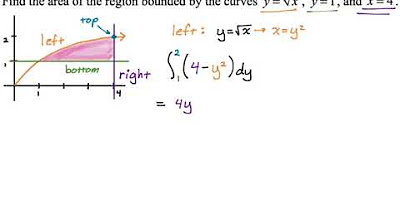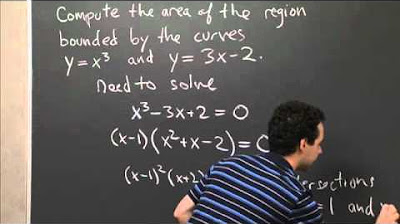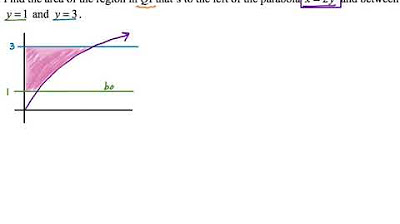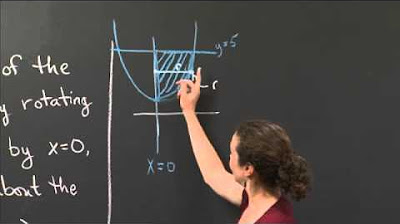Double integrals 5 | Double and triple integrals | Multivariable Calculus | Khan Academy
TLDRThe video script discusses the concept of double integrals with variable boundaries, using the specific example of a surface defined by z = xy^2. The focus is on visualizing and understanding the boundaries for integration rather than the integration process itself. The example given involves integrating over a bounded domain where x ranges from 0 to 1 and the lower boundary in terms of y is a curve defined by y = x^2. The script emphasizes the importance of identifying the correct bounds for the integral and suggests that once these are established, the actual integration is relatively straightforward.
Takeaways
- 📈 The concept of double integrals is being discussed, specifically where the boundaries on x and y are variables.
- 🌟 The main focus of the lesson is to visualize and understand the boundaries of integration rather than the integration process itself.
- 🔍 The difficulty in double integral problems lies in identifying the correct boundaries for integration.
- 📊 An example is given where the surface is defined by z = xy^2 and the boundaries are not fixed but variable.
- 🖌️ The讲师 draws the axes and the boundary on the xy-plane to help visualize the problem, emphasizing the importance of understanding the boundaries.
- 📐 The讲师 describes the process of calculating the volume under the surface by summing up small areas (da) and multiplying by the function's value.
- 🔄 The讲师 suggests integrating first with respect to x, then y, to find the volume under the surface.
- 🌐 The讲师 illustrates that the lower bound of integration for x is determined by the curve y = x^2 (or x = √y).
- 🔢 The upper bound for x is a fixed value (x = 1), while the lower bound for y is 0 and the upper bound for y is 1.
- 📝 The讲师 writes down the double integral in terms of x and y with their respective bounds of integration.
- 🚀 The讲师 mentions that the actual evaluation of the integral will be covered in the next video.
Q & A
What is the main focus of the video script?
-The main focus of the video script is to demonstrate how to visualize and think about double integral problems where the boundaries on x and y are variables, rather than fixed constants.
What is the significance of visualizing the boundaries in double integral problems?
-Visualizing the boundaries is significant in double integral problems because it helps to understand the region of integration and is crucial for setting up the correct integration limits, which is often the most challenging part of solving these problems.
What is the surface described in the script?
-The surface described in the script is z = xy^2.
How does the script suggest approaching the integration process?
-The script suggests approaching the integration process by first visualizing the boundaries and understanding the region of integration, then breaking the volume into small elements (dx * dy), and finally summing these elements over the defined domain.
What are the variable boundaries mentioned in the script for the x and y axes?
-For the x-axis, the boundary varies from 0 to 1, and for the y-axis, the lower bound is 0, while the upper bound is 1.
How is the lower bound for the x-axis determined when integrating with respect to x?
-The lower bound for the x-axis when integrating with respect to x is determined by the curve y = x^2, which represents the function x as a function of y (or x = √y).
What is the process for calculating the volume under the surface described?
-The process for calculating the volume under the surface involves summing the products of small rectangular areas (dx * dy) times the height of the surface (f(xy^2)) over the defined domain, and then integrating along the remaining axis (y-axis).
What is the role of the curve y = x^2 in the double integral problem?
-The curve y = x^2 serves as the lower boundary for the x-axis when integrating with respect to x, indicating where the integration starts along the x-axis for each value of y.
How does the script illustrate the concept of breaking down the volume into small elements?
-The script illustrates the concept by imagining the volume as a series of small rectangles, each with a base of dx and a height of dy, and then summing these elements over the defined domain to approximate the total volume under the surface.
What is the final form of the double integral as presented in the script?
-The final form of the double integral presented in the script is ∫ from y=0 to y=1 of (∫ from x=√y to x=1 of xy^2 dx) dy.
Outlines
📚 Introduction to Variable Boundaries in Double Integrals
The paragraph begins by contrasting previous double integral problems with the current one, where the boundaries for x and y are variables rather than fixed values. The focus is on visualizing and understanding the problem, as identifying the boundaries is the most challenging aspect. The example provided involves a surface defined by z = xy^2 and the goal is to find the volume under the surface, but with variable boundaries. The x-axis ranges from 0 to 1, and the y-axis is defined by a curve y = x^2, which simplifies to x = √y since we are only considering the first quadrant. The visualization of the problem is emphasized, with the speaker drawing abstract representations of the axes and the bounded domain to calculate the volume.
📈 Visualizing Integration Bounds and Setting Up the Double Integral
This paragraph delves deeper into the process of setting up the double integral with variable bounds. It emphasizes the importance of understanding the bounds of integration, which is the key to solving the problem. The speaker illustrates the concept by drawing the xy-plane and explaining how to visualize the integration process. The paragraph explains that the volume is calculated by summing up the areas of small rectangles (dx * dy) above the curve y = x^2, with the height of each rectangle determined by the function z = xy^2. The process of integrating with respect to x while holding y constant is described, with the lower bound of integration being the curve x = √y. The paragraph concludes by setting up the double integral in the order of integrating with respect to x first from 0 to 1, and then integrating with respect to y from 0 to 1. The speaker acknowledges that the actual evaluation of the integral will be covered in the next video.
Mindmap
Keywords
💡double integrals
💡boundaries
💡integration
💡volume
💡variable bounds
💡xy-plane
💡surface
💡visualization
💡summing
💡curve
Highlights
The discussion focuses on double integrals with variable boundaries, which is a more complex scenario than fixed boundaries.
The main challenge in double integral problems is visualizing and understanding the boundaries, rather than the integration itself.
The example provided involves a surface defined by z = xy^2, which was previously discussed, but now with variable boundaries.
The boundaries are defined by x ranging from 0 to 1 and a curved boundary in the y direction defined by y = x^2.
The visualization of the problem is emphasized over the actual drawing of the surface, as the boundaries are the key to solving the integral.
The method of calculating the volume under the surface involves breaking it down into infinitesimally small rectangular areas (da) and summing their volumes.
The process of integrating can be done by first summing over x (integrating with respect to x) or y (integrating with respect to y).
For a fixed y, the lower bound of integration in the x direction is given by the curve x = sqrt(y), which is a variable boundary.
The upper bound for the x integration is x = 1, a straightforward constant boundary.
After calculating the volume above a single column, the next step is to sum these volumes over the entire domain by integrating with respect to y.
The lower bound for the y integration is y = 0, and the upper bound is y = 1, defining the complete region of integration.
The double integral is expressed as an integral from sqrt(y) to 1 of xy^2 dx dy, with y ranging from 0 to 1.
The video emphasizes the importance of understanding the geometric setup of the problem, which is crucial for setting up the correct integral.
The video concludes with a promise to evaluate the double integral in the subsequent video, maintaining the viewer's interest.
The approach to solving the problem is to first visualize the boundaries and then apply the principles of double integration.
The video serves as a lesson in not only mathematics but also in developing visual and spatial reasoning skills for problem-solving.
Transcripts
Browse More Related Video

Triple integrals 3 | Double and triple integrals | Multivariable Calculus | Khan Academy

Surface integral ex2 part 1: Parameterizing the surface | Multivariable Calculus | Khan Academy

Area Between Curves: Integrating with Respect to y (Example 3)

Area Between y=x^3 and y=3x-2 | MIT 18.01SC Single Variable Calculus, Fall 2010

Area Between Curves: Integrating with Respect to y (Example 1)

Volume of a Paraboloid via Disks | MIT 18.01SC Single Variable Calculus, Fall 2010
5.0 / 5 (0 votes)
Thanks for rating: